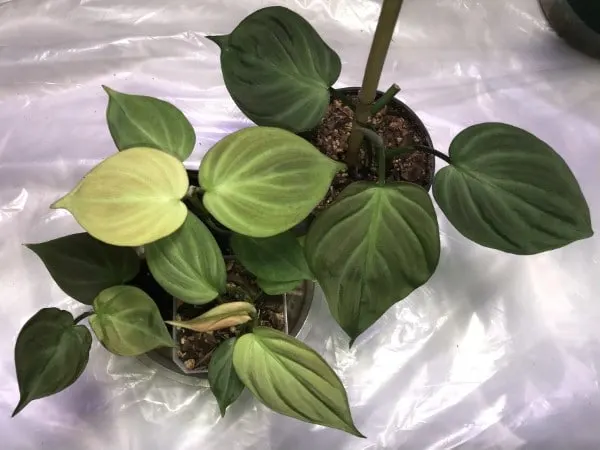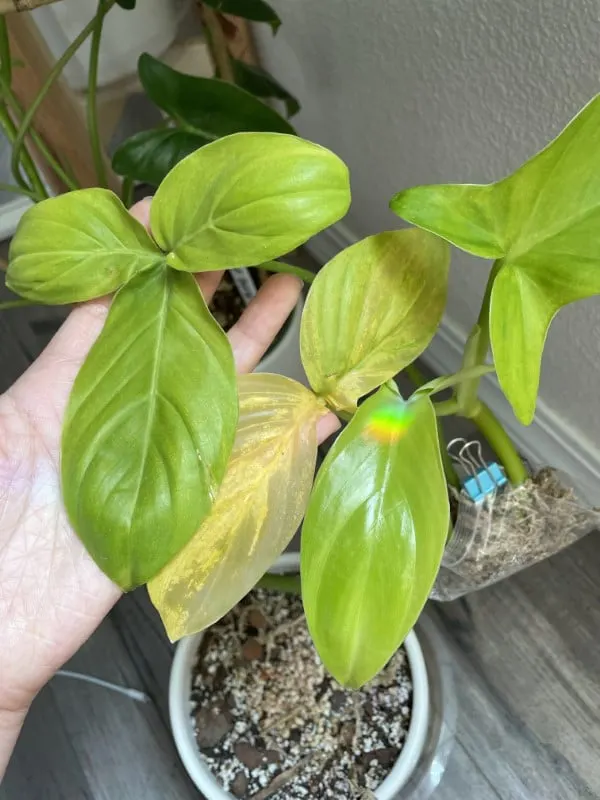Philodendron camposportoanum is an epiphytic plant that is native to tropical forests of South and Central America. It is very popular among houseplant lovers because of its evergreen foliage, velvety texture, and three-lobed shape.
Like other philodendrons, Philodendron camposportoanum’s leaves will change their appearance with time. When young, the leaves of this plant are oval-shaped, small, with a maroon shine, which is visible in direct sunlight.
When the plant matures, its leaves develop the characteristic of a three-lobed shape. The leaves can go to 12 inches when the growing conditions are good.
Philodendron camposportoanum grows tall to about 8 inches, but the vines may grow 3 feet long. It is both the trailing and climber vine, and you may grow it in a hanging basket and on the moss pole.

Care tip for philodendron camposportoanum
1. Humidity
Philodendron camposportoanum grows best when the humidity is high. You need to spray the flower daily with a spray bottle. It will not be superfluous to put saucers with wet expanded clay or water next to the pot.
Shower the plant regularly, as dust accumulated on the leaves makes gas exchange difficult. Sometimes this plant is extremely sensitive to dry indoor air.
2. Watering
The plant needs frequent and abundant watering. Water should be well purified and warm. Drain any excess water from the pot immediately. The soil should not be swampy, but it must be constantly moist. If the air temperature is low, stop watering.
3. Temperature
Philodendron camposportoanum does amazingly well at room temperatures. Likewise, it is comfortable in the same place as the owners. This plant does well with temperatures ranging between 16 and 24 degrees.
When the temperature rises, it is better to take measures to increase the humidity of the air. Spraying the leaves is the most effective way.
You should not allow the room temperature below 13 degrees in winter. Usually, the cold immediately leads to a partial loss of leaves, so in winter, if there is a risk of hypothermia of the substrate, it is better to leave the philodendron camposportoanum in warmer rooms. Soil temperature in pots is much more important than the air temperature.

4. Fertilizer
For good development and growth, philodendron camposportoanum must be fed. Especially a young plant needs this when there is an active period of growth.
Under natural conditions, rotted leaves, plant roots, and organic components serve as fertilizer. Also, various mineral, organic, or complex fertilizers can be used in room conditions.
From March to September, you should feed the flower every 2 weeks. In winter, the philodendron camposportoanum is fed once a month. If it is kept in a cool room, this is not worth doing.
5. Soil
The basic rule for soil selection is good porosity. Dense and heavy clay soil will interfere with the development and respiration of the root system.
There are two options for soil selection. You can purchase a ready-made one that is specifically suited for growing philodendrons. It contains all the necessary components for the normal development and growth of the plant.
Likewise, you can prepare your soil. To do this, you need to take a mixture for growing philodendrons. As a rule, it consists of peat, bark, coal, and sphagnum.
Add high-moor peat, a little sand, and leaf humus to it. Such a composition is considered the most optimal. It quickly passes water, retains moisture, prevents the soil from becoming heavier, and the roots breathe well.
6. Top dressing
Fertilize the soil mixture from May to September, two to four times a month. There should be 6 to 12 top dressings per season, about 1 time in 2 weeks.
As for fertilizer, use an organic compound highly diluted with water. The rest of the time, feed the plant 1 or 2 times a month with a mineral complex. Young plants planted in fertile soil need to be fed much less frequently.
7. Transplanting
Philodendron camposportoanum is transplanted as needed. The young plant grows well and develops quickly with proper care, so it is transplanted once a year or every two years into a larger pot.
Mature plants do not need frequent repotting. This should be done every 4 years or as an emergency. But the top layer of the soil is recommended to be updated often.
Propagation methods
a) Propagation by cuttings
To do this with cuttings, they should be rooted in damp sand at 25°C. This will create a nice moist environment for rooting.
The cuttings are covered with a film or a glass jar, removed every two days, and allow the plant to ventilate and breathe. After the roots appear, they can be planted in a wide pot (10 cm high).
b) Propagation by stem segments
To propagate philodendron camposportoanum using stem segments, the cut pieces must be placed in a box with sand and peat. In this case, the shoots should be at the top.
Parts of the plant are sprinkled with sand, moistened, and covered with a film. Once a week, the film is removed so that the cuttings breathe. After the roots appear, you can transplant them into a pot.
Diseases and pests
Philodendron camposportoanum can be attacked by scale insects, which are harmful insects belonging to the Hemiptera family. During the lesion, brown plaques form on the leaves.
Gradually, they begin to turn yellow, dry, and fall off. You can fight the scale insect by treating the leaves with soapy water. Then they are sprayed with Actellik solution.
Spider mite can affect the plant’s stems, between which a whitish web appears. As a result, the leaves of philodendron camposportoanum begin to dry and fall off.
Spider mites can occur due to too dry air. Control measures can be applied the same as for the defeat of the scale insect.
Thrips can also attack camposportoanum, which often appears in conditions of improper care. Its appearance is promoted by low humidity and too high a temperature. Thrips affects the leaves, which form a gray-brown coating. To get rid of it, you can spray with insecticides.
Conclusion
Philodendron camposportoanum is a tropical houseplant that originated from South and Central America. This plant can be grown as the trailing plant on the moss pole or hanging baskets. When caring for philodendron camposportoanum, it can be easy and fun if you offer it the correct growing conditions.
